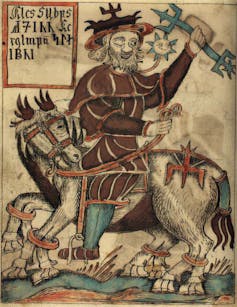A new find from Denmark, dubbed the Vindelev bracteate, has challenged previous understanding of religion in late prehistoric and early medieval Scandinavia.
The discovery of the oldest recorded mention of the god Odin – usually known from much later stories of Norse mythology – pushes the age of this deity back at least 150 years to the early 5th century. Odin is a complex and fascinating deity and the new find offers insights into the worldviews of ancient Scandinavians.
In 2020, a hoard of gold objects from the 5th century was found in Jutland, Denmark. Among the objects was a Scandinavian-style “bracteate” – a type of pendant modelled on Roman coins and medallions.
More than a thousand of these bracteates have been found across Europe. Most were likely made in south Scandinavia and feature depictions of animals and human or human-like figures.
The Vindelev bracteate is particularly large and displays a human head (probably male) and a galloping horse. The gold pendant has also been inscribed with runes – an alphabet used in Scandinavia for almost 1,000 years before the Latin alphabet took over.
Rune experts Lisbeth Imer and Krister Vasshus of the National Museum of Denmark and Sagnlandet Lejre museum have examined the inscription. While the full interpretation will be published next month, they have identified the name Jaga, or Jagaz, and the phrase “Odin’s man”.
Runes and bracteates all emerged from a melting pot of beliefs, ideas and technologies between the Roman Empire and their northern neighbours and attackers, the Germanic “barbarians”. The gold from which they were made and, probably, the Norse gods themselves came from the same pot.
Imer and Vasshus argue that Jagaz was a king and cult leader among a south Scandinavian tribe. However, when it comes to prehistoric iconography, scholars can be a bit obsessed with kings. In reality, there is no direct information about who the figure is. He could be a warrior, a shaman, a medicine man – all or none of the above.
Odin: shaman, shape-shifter, queer?
Odin was a pan-Germanic god known as Wuotan, Wōden and Óðinn across northern Europe before the conversion to Christianity (although belief in the Norse gods probably continued in remote areas for some time).

Odin, the king of the gods, was associated with war and the dead. According to later medieval sources, he ruled over the death realm known as Valhall (the hall of the slain warriors). We preserve his Old English name in our word Wednesday: Wōden’s day.
In later written sources, Odin is known by over 200 names, among them “the masked one”, “terrible/ugly one” and my personal favourite: “horsehair-moustache”.
Odin had shamanistic qualities. He sacrificed one of his eyes to gain wisdom and hanged himself from Yggdrasill (the world tree) for nine nights in order to learn to read runes.
Odin had the capacity to shape shift into animal form and could send his thoughts and intent into the world in the form of two ravens called Munin and Hugin. As 12-13th century Icelandic writer Snorri Sturluson describes:
Odin could transform his shape: his body would lie as if dead, or asleep; but then he would be in shape of a fish, or worm, or bird, or beast, and be off in a twinkling to distant lands.
Odin was a master of seiðr. Seiðr was a magical, ritual practice involving chanting, drumming and seeing into the future or speaking with the dead.
According to Snorri, Odin learned seiðr from the goddess Freyja. However, because seiðr was associated with women and because its ecstatic components may have had sexual allusions, it was seen as unmanly. This has led some scholars to question whether Odin was a queer god, or gender fluid.
What does the Vindelev bracteate tell us?
Despite the popularity of the Norse gods today, much about their history remains uncertain. The historical sources describing these gods were written centuries after the fact by Christian authors. How reliably they describe Viking age beliefs has been debated.
The find adds to several objects that confirm that the written sources are not purely the inventions of Christian authors in high medieval Scandinavia.
Read more: Why Old Norse myths endure in popular culture
Whether the Odin of the Vindelev bracteate is quite the same character as the Odin of the medieval sources almost 1,000 years later is difficult to ascertain. But the name had deep roots among the Scandinavians. The new discovery also places the deity among the Germanic peoples who contributed to the fall of the western Roman Empire.
As a scholar researching the human body in the Iron and Viking ages in northern Europe, I am intrigued by the figure’s hair, which may be connected to sacrificed braids found in bogs in Scandinavia from centuries earlier.
This provides clues about hairstyles and body ideals at the time and supports evidence that hair was an especially important and meaningful part of the body.
While the mention of Odin is unparalleled, the glimpse of Jagaz (whoever he was) is also fascinating. We can speculate that he lived in the early 400s in what is now Denmark, adorned his hair with a braid, believed in Odin and had a horse companion.
He may have practised something akin to seiðr. Perhaps he journeyed to the Roman Empire and served as a soldier, returning with experiences of exotic animals, enormous monuments, foreign languages and gods that his community would have difficulty grasping. Perhaps he used his pay to have an exaggerated bracteate made, that he would ultimately sacrifice in a gold hoard in the ground.
Despite gaps in the story, the Vindelev bracteate opens new possibilities to imagine the decidedly foreign worlds of past people – and their gods.
Marianne Hem Eriksen does not work for, consult, own shares in or receive funding from any company or organization that would benefit from this article, and has disclosed no relevant affiliations beyond their academic appointment.
This article was originally published on The Conversation. Read the original article.







